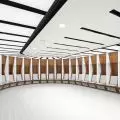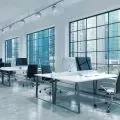"10 Questions to an Interior Designer" is a series of short talks inspired by the series "10 Questions to...".This time our attention is turned to interior architects. In today's episode, Estera and Robert Sosnowski of Studio Projekt talk about their approach to design.
Studio Projekt - an award-winning interior design studio. Estera and Robert Sosnowski are known for their creativity, high quality finishes and attention to detail. They specialize in private, commercial and public interiors projects. The architects from Studio Projekt also have experience in being jurors of industry competitions. They also share their knowledge in the media.
1 For us, home is...
A place that I associate well and where we are happy. Home is not just a building. It is also our memories and experiences. A place from which we draw strength to fight problems and to which we are emotionally attached. It's where we always want to return. A real home is made by people.
2 The key to a successful interior design is.
Understanding the client is the first and most important skill that every interior designer must possess. It is a prerequisite. The better you know the needs of the investor, the better you can design the space. The architect must work with clients, discuss their ideas, budget, requirements and much more. The designer has to find a balance between aesthetics and investors' needs. It is important for him to understand the clients' lifestyles, as the interior design largely depends on this.
3 We look for inspiration....
In nature and everyday life. They do not have to come only from the world of design. Nature, art, fashion and even ordinary objects can be a source of creative ideas. Take a walk, visit a museum or go to a new city. Look out for colors, textures and patterns that you can incorporate into your design.
When we travel, we see the world from a different perspective. We can borrow different ideas and then adapt them to our design or find new solutions. Exploring unknown, exciting areas translates into interesting concepts. Thus, we can say that travel initiates a change in perspective and is a source of valuable inspiration. Through them we discover aesthetic tastes and trends. Our horizons and capabilities expand, and this translates into the way we do our work. Traveling also allows us to immerse ourselves in a different world of design and culture. Through this we become even better in our field.
4 In cooperation with a developer the most important thing is....
Trust, honesty and open and clear communication. If you decided to work with an interior designer, this decision must have come from something. So you turn to a specialist in this field. You need to trust the architect in order for the cooperation to be fruitful. The designer, on the other hand, should be able to explain every decision you make. This will confirm his knowledge and experience. Trust also lies in the promise to fulfill the contract. By signing the contract, both the investor and the architect define the terms of cooperation based on, among other things, mutual trust. You trust the designer to deliver on the documentation and prepare the project of your dreams within the specified timeframe. In turn, the architect trusts that he has your confidence. Some of the most important elements of a successful cooperation between a developer and an interior designer are precisely trust and sincerity.
5 Our favorite design style is.
Minimalism and japanese.
The minimalist style emphasizes simplicity in all aspects of interior design, from furnishings to neutral color palettes to non-extravagant accessories. The interior is furnished with only the necessary, simple elements.
Japandi, on the other hand, is a blend of Scandinavian and Japanese design. This design movement blends east and west. In it, Japanese artistic elements and the wabi-sabi philosophy are intertwined with Scandinavian comfort and warmth and hygge. Both Japanese and Scandinavian design aesthetics focus on simplicity, natural elements, comfort and sustainability.
6 The most valuable object in my home is....
To quote Albert Einstein:
The most valuable things in life are not acquired with money.
Health, love, time, peace and family are the most valuable things in our home.
7 The most common mistake in self-decoration is.
Bad lighting. This is a thing that many people do not pay attention to. However, it plays a huge role in how people perceive a space. For example, one color of paint under an incandescent light bulb can look completely different than in natural light. If your home is dark, you can simply replace a couple of light bulbs or install some wall sconces to make the space brighter.
Incorrectly measuring the room or skipping this step altogether. If you assess the space "by eye," you may find that the furniture doesn't fit. How to avoid this? The best way is to measure everything twice.
A common mistake in interior design is also that people don't engage architects early enough. We should be there as soon as we decide to build or renovate. Often clients contact designers after they have already purchased a house and hire a contractor only for kitchen and bathroom renovations. Once construction is underway, owners are overwhelmed by having to make many decisions. Contact us and don't hire a contractor until you talk to a designer first.
8 Our favorite material is.
Wood is the essence of timelessness in interiors. It is both a finishing and decorative material. It is warm, friendly and pleasant to the touch. It also allows you to commune with what is natural. It also comes in all styles of interior design.
9 A trend we wish would pass away already is.
Lofts. They seem cool in theory. However, it is difficult to find a place to relax and calm down in them. Like open spaces, lofts offer no privacy. They can also be loud and echoing. While they are the epitome of cool, sophisticated city living, they have many drawbacks, such as when it comes to functionality. Yes, high ceilings and sunlight photograph well, but lofts often lack storage space, and heating a high space can be difficult as well as expensive.
10:We would like, someday, to live in....
Italy. Italians are role models. We should take the best from them. The way of looking at life, joy, kindness and friendliness. Also a sense of style and sensational food.
Check out other conversations in our series of 10 questions for interior designers































